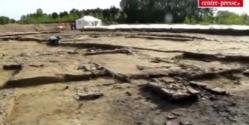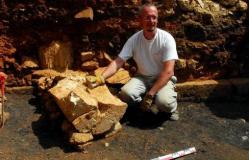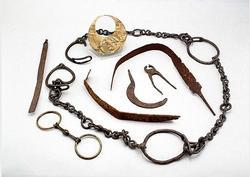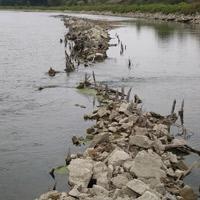INSTITUT SUPERIEUR D'ANTHROPOLOGIE
INSTITUTE OF ANTHROPOLOGY
ONLINE COURSES / COURS A DISTANCE
INSCRIPTION 2012 / Session III : Juillet 2012
REGISTRATION 2012 / Term III : July 2012
FRANCE –  Marigny-Brizay - Bien sûr, on trouvait bien de temps en temps une vieille tuile qui traînait au milieu des bois. Mais personne n'imaginait que là, sous les arbres sommeillaient les vestiges de ce qui fut sans doute, voici deux millénaires, une villa gallo-romaine. La découverte, dans un hameau de Marigny-Brizay, on la doit au chantier de la LGV, tout comme celle de plusieurs autres sites dans la Vienne (à Vouneuil-sous-Biard par exemple), les Deux-Sèvres (un camp fortifié romain à Pliboux), la Charente ou l'Indre-et-Loire. C'est l'Inrap qui, le premier, a donné l'alerte : il y a quelque chose d'intéressant sous nos pieds. Quelques tranchées témoin dans la trouée effectuée dans la forêt laissaient apparaître des maçonneries. C'est ainsi qu'on a fait apparaître, sur quelque 1.800 m2, les vestiges d'un ancien bâtiment reconstruit par deux fois à l'aube de notre ère, qui pourrait avoir été une grange, bien que le revêtement de son sol soit particulièrement élaboré. Un peu plus loin, les six jeunes archéologues d'Eveha ont découvert les restes de bains privés dont la conception, typiquement gallo-romaine, n'est pas sans rappeler certaines ruines de Pompéi. Et un puits antique, fait de pierres de silex superposées sans maçonnerie, et comblé avec des débris de construction.
Marigny-Brizay - Bien sûr, on trouvait bien de temps en temps une vieille tuile qui traînait au milieu des bois. Mais personne n'imaginait que là, sous les arbres sommeillaient les vestiges de ce qui fut sans doute, voici deux millénaires, une villa gallo-romaine. La découverte, dans un hameau de Marigny-Brizay, on la doit au chantier de la LGV, tout comme celle de plusieurs autres sites dans la Vienne (à Vouneuil-sous-Biard par exemple), les Deux-Sèvres (un camp fortifié romain à Pliboux), la Charente ou l'Indre-et-Loire. C'est l'Inrap qui, le premier, a donné l'alerte : il y a quelque chose d'intéressant sous nos pieds. Quelques tranchées témoin dans la trouée effectuée dans la forêt laissaient apparaître des maçonneries. C'est ainsi qu'on a fait apparaître, sur quelque 1.800 m2, les vestiges d'un ancien bâtiment reconstruit par deux fois à l'aube de notre ère, qui pourrait avoir été une grange, bien que le revêtement de son sol soit particulièrement élaboré. Un peu plus loin, les six jeunes archéologues d'Eveha ont découvert les restes de bains privés dont la conception, typiquement gallo-romaine, n'est pas sans rappeler certaines ruines de Pompéi. Et un puits antique, fait de pierres de silex superposées sans maçonnerie, et comblé avec des débris de construction.
VIDEO = http://www.lanouvellerepublique.fr/Vienne/Actualite/Economie-social/n/Contenus/Articles/2012/05/11/La-LGV-ressuscite-nos-ancetres-les-Gaulois
FRANCE –  Poitiers - Quand les urbanistes de Coeur d'agglo ont décidé de créer une nouvelle fontaine rue du Puygarreau, derrière la mairie, ils n'imaginaient pas que d'autres avaient déjà eu la même idée... il y a 17 siècles. Les fouilles archéologiques en cours ont en effet permis de mettre au jour un bassin antique et plusieurs vestiges de colonnes. Il y a plusieurs semaines, le chantier de Coeur d'agglo avait révélé à cet endroit un rempart du bas empire, ainsi que des remblais du XIX siècle et une construction datant au moins du XVII. Christophe Belliard, l'archéologue chargé du suivi de Coeur d'agglo, avait aussi découvert des morceaux de colonne du IV siècle. Devant la richesse du site, le service régional d'archéologie a prescrit des fouilles, menées par l'Inrap (Institut national de recherches archéologiques préventives) sous la responsabilité de Frédéric Gerber.
Poitiers - Quand les urbanistes de Coeur d'agglo ont décidé de créer une nouvelle fontaine rue du Puygarreau, derrière la mairie, ils n'imaginaient pas que d'autres avaient déjà eu la même idée... il y a 17 siècles. Les fouilles archéologiques en cours ont en effet permis de mettre au jour un bassin antique et plusieurs vestiges de colonnes. Il y a plusieurs semaines, le chantier de Coeur d'agglo avait révélé à cet endroit un rempart du bas empire, ainsi que des remblais du XIX siècle et une construction datant au moins du XVII. Christophe Belliard, l'archéologue chargé du suivi de Coeur d'agglo, avait aussi découvert des morceaux de colonne du IV siècle. Devant la richesse du site, le service régional d'archéologie a prescrit des fouilles, menées par l'Inrap (Institut national de recherches archéologiques préventives) sous la responsabilité de Frédéric Gerber.
« Nous avons trouvé la base d'une colonnade, et une autre colonne encore en place, avec le reste de cette colonne effondré à côté, détaille-t-il. On peut imaginer qu'il y avait une colonne à chaque angle du bassin qu'elles encadrent. On a déduit qu'il s'agissait d'une fontaine car on reconnaît l'usure sur les blocs calcaires, typiques d'un jet d'eau qui les frappe en continu. C'est exactement ce qu'on avait constaté comme marques sur la fontaine trouvée lors du chantier de fouille des Hospitalières en 2005. Nous avons aussi les vestiges d'un corridor qui faisait le tour du bassin. »
http://www.centre-presse.fr/article-194923-une-fontaine-antique-br-sous-la-future-fontaine.html
ROYAUME UNI –  Lough Foyle - The mystery of the ‘submarine’ in Lough Foyle has been solved. The answer? A rocky outcrop and a lot of man-made debris. On a visit to Londonderry yesterday, Environment Minister Alex Attwood revealed what divers sent down to investigate the anomaly on the bed of Lough Foyle had discovered. At one point it was believed the boat-shaped image sighted in a sonar scan could have been the wreck of a WWII submarine. But after sonar scans, it emerged the image was a strange pattern. Divers from the Centre For Maritime Archaeology were sent down to inspect the lough bed on May 4. With visibility at no more than a few feet, they were forced to carry out fingertip surveys of the area. The minister said: The dive has concluded that there is a seam or ridge of bedrock/rock outcrop on the riverbed, around which there is various debris.
Lough Foyle - The mystery of the ‘submarine’ in Lough Foyle has been solved. The answer? A rocky outcrop and a lot of man-made debris. On a visit to Londonderry yesterday, Environment Minister Alex Attwood revealed what divers sent down to investigate the anomaly on the bed of Lough Foyle had discovered. At one point it was believed the boat-shaped image sighted in a sonar scan could have been the wreck of a WWII submarine. But after sonar scans, it emerged the image was a strange pattern. Divers from the Centre For Maritime Archaeology were sent down to inspect the lough bed on May 4. With visibility at no more than a few feet, they were forced to carry out fingertip surveys of the area. The minister said: The dive has concluded that there is a seam or ridge of bedrock/rock outcrop on the riverbed, around which there is various debris.
http://www.belfasttelegraph.co.uk/news/local-national/northern-ireland/foyle-submarine-is-just-rock-and-debris-reveals-minister-16157225.html
ROYAUME UNI – Croyde - Historians have shed new light on four skeletons found buried near a beach – by studying their buttons. They believe the four men, found in the 1990s buried near Croyde, North Devon, probably drowned in a shipwreck. But clues from the skeletons and their buttons – the only part of their clothing to survive – suggest they were probably not seamen but wealthy passengers or merchantmen. A report by Tim Gent, of Exeter Archaeology, says the burials were discovered between 1996 and 1998 at Saunton Down End. Two of the skeletons were found with finely decorated pewter buttons. This suggests they would have benefited from relatively elevated positions in life, says the report. Bone buttons found with the two other skeletons suggest they were somewhat lower on the social scale. Charlotte Coles, from Exeter Archaeology, studied three of the skeletons and concluded that two of the men were aged between 35 and 40 years when they died. The third, the tallest man at 6ft, was aged 25-30. Their teeth were in good condition and the bones in relatively good shape. She said in the report: "If these were naval seamen, or men who spent a great deal of time at sea, more severe trauma or illness might be expected, with falls, breaks and infection being very common among sailors."
http://www.thisissomerset.co.uk/button-clothing-remnants-shed-new-light/story-16041851-detail/story.html
ROYAUME UNI –  Llyn Cerrig Bach - The many remarkable artefacts discovered at Llyn Cerrig Bach near Valley on Anglesey 70 years ago will be exhibited at Oriel Ynys Môn this summer. Llyn Cerrig Bach is a small lake in North West Anglesey, near Valley. The spectacular group of Iron Age artefacts were uncovered by head groundsman W.O. Roberts and his fellow workmen as they dredged the lake in preparation for the extension of the runway at RAF Valley in 1942, and they have fascinated archaeologists ever since. The overall collection of around 170 objects comprises a wide range of objects, including fragments of cauldrons, a crescentic-shaped plaque with Celtic Art decoration and part of an ancient trumpet or war horn. Also represented are many horse harness fittings and parts of chariots, used in war and for display. A significant collection of weaponry was also recovered, including a magnificent decorated shield-boss, iron swords and spearheads. Iron bars, probably used as traded raw materials, and a range of iron tools also provide insight into the skills of the blacksmith and objects in everyday use during the Iron Age. The first object to be found was a heavy iron gang chain, used for slaves. This was not immediately identified as an ancient artefact, and was used as a tow-chain for tractors to pull trucks that were bogged down in the mud. Despite being around 2000 years old, the chain performed this task remarkably well. Once the chain was identified as an ancient artefact, a search of the immediate area produced a number of other objects.
Llyn Cerrig Bach - The many remarkable artefacts discovered at Llyn Cerrig Bach near Valley on Anglesey 70 years ago will be exhibited at Oriel Ynys Môn this summer. Llyn Cerrig Bach is a small lake in North West Anglesey, near Valley. The spectacular group of Iron Age artefacts were uncovered by head groundsman W.O. Roberts and his fellow workmen as they dredged the lake in preparation for the extension of the runway at RAF Valley in 1942, and they have fascinated archaeologists ever since. The overall collection of around 170 objects comprises a wide range of objects, including fragments of cauldrons, a crescentic-shaped plaque with Celtic Art decoration and part of an ancient trumpet or war horn. Also represented are many horse harness fittings and parts of chariots, used in war and for display. A significant collection of weaponry was also recovered, including a magnificent decorated shield-boss, iron swords and spearheads. Iron bars, probably used as traded raw materials, and a range of iron tools also provide insight into the skills of the blacksmith and objects in everyday use during the Iron Age. The first object to be found was a heavy iron gang chain, used for slaves. This was not immediately identified as an ancient artefact, and was used as a tow-chain for tractors to pull trucks that were bogged down in the mud. Despite being around 2000 years old, the chain performed this task remarkably well. Once the chain was identified as an ancient artefact, a search of the immediate area produced a number of other objects.
http://www.newswales.co.uk/?section=Culture&F=1&id=24423
FRANCE – Saint Léger la Pallu - A quelques kilomètres dur chantier de Marigny-Brizay, l'Inrap pense avoir fait grâce à ses fosses de sondage une autre découverte qui pourrait s'avérer intéressante, à Saint-Léger-la-Pallu.
Il pourrait s'agir d'un site d'extraction du minerai de fer. Les archéologues ont quelque espoir de trouver sur place les vestiges d'une forge antique.
http://www.lanouvellerepublique.fr/Vienne/Actualite/Economie-social/n/Contenus/Articles/2012/05/11/Mystere-a-Saint-Leger
FRANCE –  La Loire - L’Université de Nantes pilote depuis 2011 un grand projet de recherche dédié à l’étude de la Loire aval. Coordonné par Rémy Arthuis, chercheur au Centre de Recherche en Archéologie, Archéosciences, Histoire (CReAAH) et géomorphologue à l’INRAP, le programme se donne pour objectif de connaître l’évolution du fleuve depuis les dix derniers millénaires. Inscrit jusqu'en 2013, le nouveau PCR va ainsi pouvoir implanter 9 forages carottés dont les prélèvements seront soumis à une série d'analyse (sédimentologie, malacologie, palynologies, datations radiocarbones, étude des foraminifères et des thécamoebiens). Des fouilles archéologiques, programmées ou préventives, auront également lieu sur plusieurs communes du département de Loire-Atlantique. "Il s'agit d'étudier les franchissements, la batellerie, les aménagements portuaires, les canaux, l'utilisation de l'énergie hydraulique, afin de renouveler nos connaissances sur les sociétés riveraines du fleuve."
La Loire - L’Université de Nantes pilote depuis 2011 un grand projet de recherche dédié à l’étude de la Loire aval. Coordonné par Rémy Arthuis, chercheur au Centre de Recherche en Archéologie, Archéosciences, Histoire (CReAAH) et géomorphologue à l’INRAP, le programme se donne pour objectif de connaître l’évolution du fleuve depuis les dix derniers millénaires. Inscrit jusqu'en 2013, le nouveau PCR va ainsi pouvoir implanter 9 forages carottés dont les prélèvements seront soumis à une série d'analyse (sédimentologie, malacologie, palynologies, datations radiocarbones, étude des foraminifères et des thécamoebiens). Des fouilles archéologiques, programmées ou préventives, auront également lieu sur plusieurs communes du département de Loire-Atlantique. "Il s'agit d'étudier les franchissements, la batellerie, les aménagements portuaires, les canaux, l'utilisation de l'énergie hydraulique, afin de renouveler nos connaissances sur les sociétés riveraines du fleuve."
http://www.univ-nantes.fr/1336563186793/0/fiche___actualite/&RH=RECH